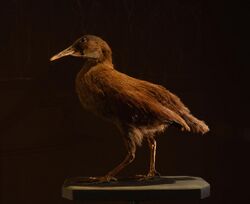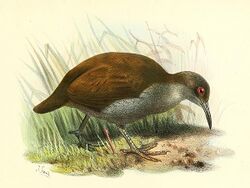Biology:New Caledonian rail
| New Caledonian rail | |
|---|---|

| |
| Stuffed specimen | |
| Scientific classification | |
| Domain: | Eukaryota |
| Kingdom: | Animalia |
| Phylum: | Chordata |
| Class: | Aves |
| Order: | Gruiformes |
| Family: | Rallidae |
| Genus: | Cabalus |
| Species: | C. lafresnayanus
|
| Binomial name | |
| Cabalus lafresnayanus (Verreaux, J & Des Murs, 1860)
| |
| Synonyms | |
| |
The New Caledonian rail (Cabalus lafresnayanus) is a large and drab flightless rail endemic to the island of New Caledonia in the Pacific. It is considered Critically Endangered or possibly extinct.
Taxonomy
It was once thought to be in the genus Gallirallus, but is now considered to be in the genus Cabalus, along with the confirmed-extinct Chatham rail. The binomial commemorates the French ornithologist Frederic de Lafresnaye.
Description
It is a dull brown above, with grey underparts, and has a yellowish, downward-curving bill. Due to it having not been seen since the 1890s, its call and daily habits are not known.
Distribution and habitat
This bird is supposed to live in evergreen forests and, if still extant, seems to have moved higher up on the island to escape introduced predators.
Ecology
This bird was host to a species of parasite, the phtilopterid louse Rallicola piageti that is not believed to have occurred on any other bird species. Hence, R. piageti may be coextinct.[1]
Status
This cryptic rail is only known from seventeen specimens taken between 1860 and 1890 on New Caledonia. It most likely was driven to extinction from predation by feral cats, dogs, and pigs. Though the bird has not been confirmed since 1890, unconfirmed reports from the 1960s and 1984 say that some still live in the higher montane forests. A survey in 1998 produced no firm evidence from hunters or fieldwork. However, it may still persist in small numbers in isolated areas.
References
- ↑ Rózsa, Lajos; Vas, Zoltán (2014-08-22). "Co-extinct and critically co-endangered species of parasitic lice, and conservation-induced extinction: should lice be reintroduced to their hosts?". Oryx 49 (1): 107–110. doi:10.1017/s0030605313000628. http://real.mtak.hu/17477/1/oryx.pdf.
External links
Wikidata ☰ Q1066511 entry
 |



